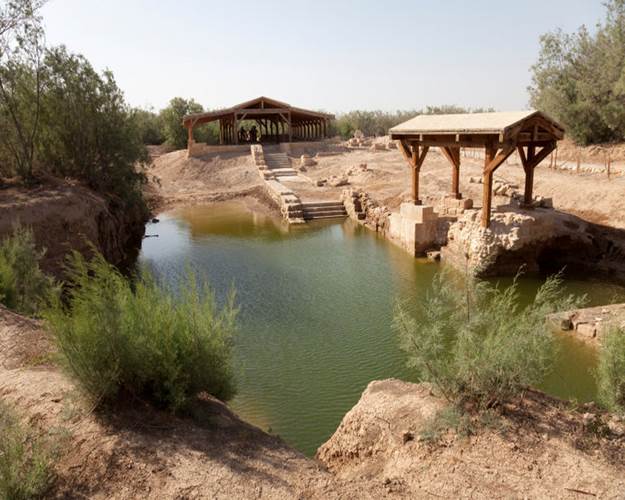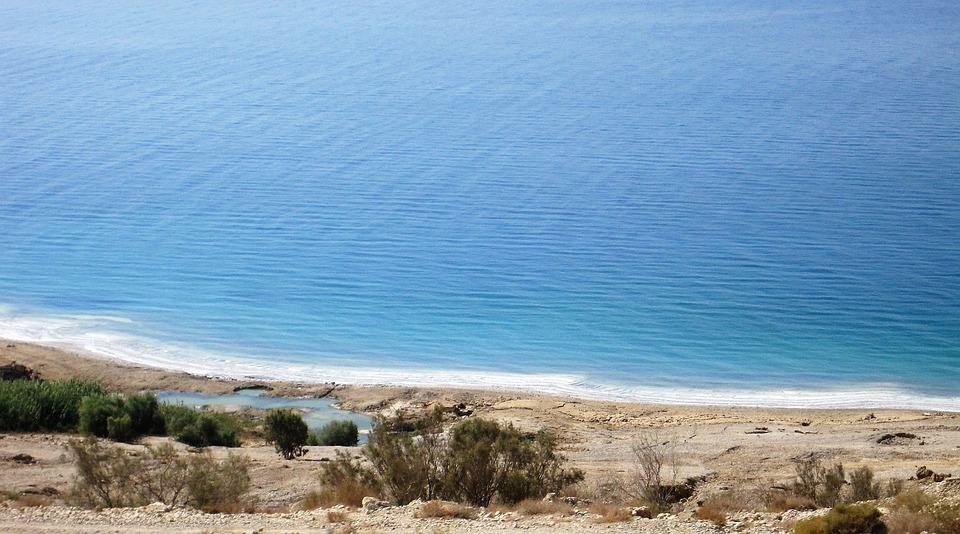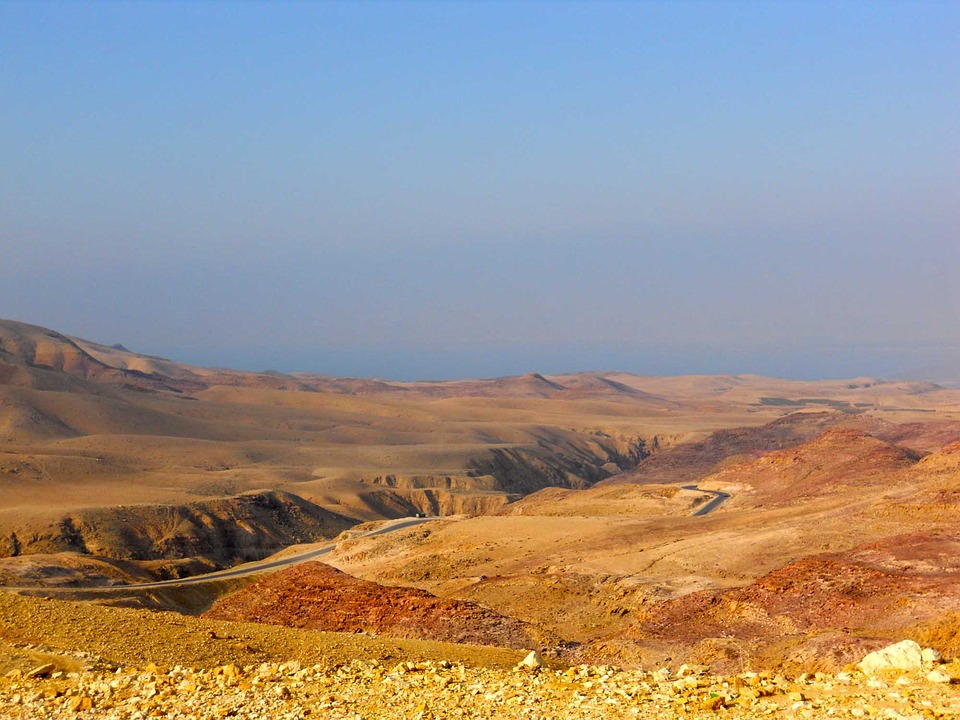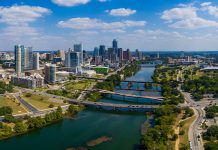Amman to the Dead Sea
The first thing you notice when you drive down from Amman to the Dead Sea is that your ears suddenly pop. That’s hardly surprising when you consider that you are dropping from 780 metres to 423 metres (1118 feet) below sea level, the lowest point on the earth. The second is the sudden change in the landscape. Gone is the sprawling, heavily congested metropolis that Amman has become, home to some 2 million people. In its place is a landscape of almost biblical proportions with brown, sun-baked hills sweeping down to the rich Jordan Valley below with the West Bank and Jericho shimmering in the distance. Lastly, is the sudden increase in temperature. 30 in Amman rapidly gives way to 45 in the space of little less than an hour. You can understand why the Dead Sea shrinks by over a metre a year through a combination of intense evaporation (10 million tons of water a day) and over-exploitation. If you decide to venture on this journey, make sure that you wear a hat, factor up to the maximum level possible and take a plentiful supply of water. It is also advisable not to follow the mad dogs and Englishmen out into the midday sun.
The Baptism Site

It is not possible to visit Bethany, also known as the Baptism Site, alone for security reasons, and you have to take the state-controlled guided tour at a cost of 12 Jordanian dinars (equivalent to approximately US$17). Fortunately, the Jordanians have recently invested in air-conditioned buses, a major improvement on the old trucks that were formerly in use. They have also gone high-tech, and with your ticket you are presented with a black plastic card with numbers on it and a pointed metal device that looks very similar to an electronic hair remover. All you have to do is to point it at one of the numbers, place it by your ear and you have a running commentary in beautifully pronounced English or one of the other 6 major languages.
You set off through an almost lunar landscape, extremely dry and barren with no signs of any water whatsoever and very little vegetation save for brush. After a stop at a security checkpoint, you are driven to Elijah’s Hill where the venerable prophet was reportedly driven up to heaven in a chariot drawn by horses of fire. An arch made up of 63 stones, one for each of year of the late King Hussein’s life, has been erected over the remains of a Byzantine church.
Shortly after, the bus parks and the rest of tour is on foot and takes approximately 45 minutes. It consists of a walk to the famous Baptism Pool blessed by Pope John Paul II himself on his visit to the Holy Land in 2000. There you can see some ancient stone foundations, a pool that was designed to hold over 300 pilgrims, and a large wooden structure called the Pilgrim’s Station. All that is left of the Jordan River is a small brackish, brown pool since Israel, Syria and Jordan itself have diverted its waters for irrigation. Gone are the wonderful springs and waterfalls described by the adventurers in the last century. Nevertheless, there is something very reverent about being in the place where Jesus was baptised by John the Baptist.
The tour continues along a meandering path through tamarisk bushes past St John’s Spring and leads on to the very ornate, modern, and gold-domed Church of St John, which was inaugurated in 2005. From here, steps lead down to a wooden platform erected by the River Jordan, which provides the frontier between Jordan and Israel. Here there is some semblance of a real river and visitors can dip their feet in the brown, murky water for absolution and gaze across at the Israeli pilgrims immersing themselves under the watchful eyes of their nervous guards. The large, fortified structures on the other side of the river contrast sharply with the simplicity of the Jordanian side, and are a stark remainder of the volatility of this area and its troubled past. Before the Peace Accord, this area would have been land-mined.
The Dead Sea

Leaving the Jordan Valley, you turn right towards the Dead Sea some 15 minutes away. The Dead Sea is 377 metres deep (1,237 feet) and the deepest hyper-saline lake in the world with a salinity of 33.7%, which is over 9 times saltier than the ocean. Hence, you are unable to sink and there is a complete absence of any aquatic life at all. It is, however, possible to purchase caps and T-shirts inscribed with Dead Sea Fishing Club, which is guaranteed to raise a smile from the folks back home.
It is an enormous sea (42 miles long and 11 miles wide), and it has a stillness that is overwhelming. There are no boats of any kind and very little activity apart from at the water’s edges. Access to it can be made via the public beaches but if you really want to indulge, take a half day at one of the many hotels (Movenpick or Marriott) dominating its coastline and indulge in the mud baths, hydrotherapy, or many of the other treatments readily available. A shower after any swim, however, is essential to remove the layer of gluey saline solution that sticks to the body.
Mount Nebo

From the Dead Sea, the road climbs steeply up to Mount Nebo (3300 feet above sea level), twisting and turning through a wild landscape populated only by Bedouins. There are magnificent views of the Jordan Valley below, the Dead Sea, and the West Bank beyond. Occasionally, a small oasis will appear and you will see olive groves clinging to the rugged hillsides. After 30 minutes Mount Nebo appears in the distance. This is the place where Moses saw the Promised Land after 40 years in the wilderness and before dying at the grand old age of 120. No one knows the exact location of his burial, but the Memorial Church of Moses, currently under reconstruction, claims to be the burial site. Pope John Paul II visited it during his pilgrimage to the Holy Land in 2000 and planted an olive tree next to the Byzantine chapel as a symbol of peace. A serpentine cross sculpture has also been erected on top of Mount Nebo. Designed by the Italian artist Giovanni Fantoni it symbolises the serpent held high by Moses and the cross on which Jesus was crucified.
MadabaFrom Mount Nebo, it’s only a short drive to Madaba, once the ceramic capital of the Roman world and famous for its mosaics. Although it is the 5th largest town in Jordan with a population of 60,000, it is small in comparison to Amman and has small twisting streets packed with shops and small schools selling mosaics, many of them made to order. Its most important tourist attraction, however, is the Greek Orthodox St. George’s Church famous for the Madaba Map. This was discovered in the nineteenth century when the church was under reconstruction and provides the oldest map of the Holy Land dating back to the 6th Century. The map covers the whole region including Jordan and Palestine in the north to Egypt in the south and provides a detailed map of Jerusalem itself with its many gates and the Church of the Holy Sepulchre. Originally measuring over 25 by 5 metres, it is comprised of over 2 million individual ceramic pieces, but only a quarter of it still remains. The Church of the Apostles is a short distance away and also has extremely well-preserved mosaic floors dating back to AD 578. A visit to the Archaeological Museum is a must to see the scale of the artistry and the legacy of the Romans.
Madaba is also famous for Haret Jdoudna, one of the most renowned restaurants in Jordan. A former clinic and residence owned by one of Jordan’s leading doctors, this Ottoman house has been transformed into a culinary paradise with every variety of oriental food presented in an atmosphere of calm tranquillity. A stone’s throw away from the town centre, the service is warm and friendly and the prices are ridiculously low for such a high quality of food. Mingle with the locals, relax, and take a brief respite from the heat. If you arrive later in the day, sit on the rooftop patio and absorb the atmosphere of this once prosperous town with its multitude of minarets and the call to prayer echoing through the alleyways.
As you drive back to Amman along the 5000-year old Kings Highway, olive groves straddle the hills, verdant lands stretch to the horizon, and you are reminded of the historical significance of the route you have just taken and of the countless pilgrims that have gone before you in search of peace, tranquility and absolution. Jordan has that effect on you.









